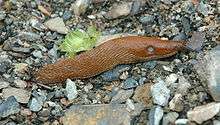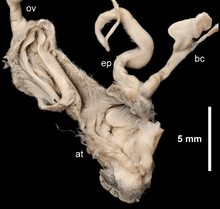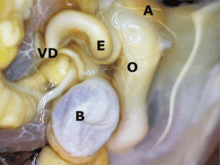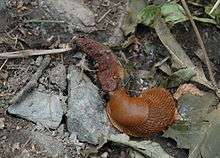Spanish slug
The Spanish slug, also known by its scientific name Arion vulgaris, more commonly known in English-speaking countries under the incorrectly applied Latin name Arion lusitanicus, is a species of air-breathing land slug, a terrestrial pulmonate gastropod mollusk in the family Arionidae, the roundback slugs.
| Spanish slug | |
|---|---|
 | |
| Scientific classification | |
| Kingdom: | |
| Phylum: | |
| Class: | |
| (unranked): | clade Heterobranchia clade Euthyneura clade Panpulmonata clade Eupulmonata clade Stylommatophora informal group Sigmurethra |
| Superfamily: | |
| Family: | |
| Genus: | |
| Species: | A. vulgaris |
| Binomial name | |
| Arion vulgaris Moquin-Tandon, 1855[1] | |
| Synonyms | |
|
Arion rufus var. vulgaris Moquin-Tandon, 1855 | |
They can lay up to 400 eggs in a single summer. These eggs often hatch within just 3.5-5 weeks.[2]
This is a highly invasive slug species. It is often considered a pest, not only in areas where it has been accidentally introduced, but even in places where it is indigenous.
Distribution
The native distribution of Arion vulgaris is not exactly known. Some sources have claimed it originates in northern Spain, western France and southern England,[4] but provided no published references for these assumptions. In Britain the slug was first recorded in 1954,[5] which does not indicate native distribution there. Reliable records from Spain have not been found although the Spanish term, babosa is found in a 1422 text.[6] Moquin-Tandon described the species originally from France without exact indication of the locality, presumably western or southwestern France.
Non-indigenous distribution
The non-indigenous distribution of Arion vulgaris includes the whole of western, central and northern Europe. Its distribution includes also various parts of Southern Europe and of Eastern Europe.[4]
Arion vulgaris is also known from the USA since 1998.[4]
Chronological overview of expansion of Arion vulgaris in Europe:
- Great Britain since 1954,[5] later spread in to Lincolnshire and Norfolk in 2012[7][8]
- France (expansion from native range) since 1955[9]
- Switzerland since at least 1956[10]
- Italy since 1965[9]
- Bulgaria since 1966[11]
- Germany since 1969[4]
- Austria since 1971[12]
- Belgium since 1973[4]
- Poland since 1985[4] or since 1996[9]
- Sweden since 1975[9] or since 1985[4]
- Norway since 1988[9][13]
- Finland since 1990[9]
- Czech Republic since 1991[4]
- Denmark since 1991[9] or since 2000[4]
- Slovakia - since 1992[11] established population[4]
- Faroe Islands - since 1996[4][14]
- Estonia[11] since 2008
- Latvia - established population[4]
- Lithuania - established population
- Ireland
- Hungary since 2000[11]
- Slovenia
- Croatia since 1996[15]
- Serbia since 2002[11]
- Iceland since 2003
- Ukraine since 2007,[11][16] widely spread across almost whole country during several following years[17]
- Romania - since 2012[11]
- Russia[17]
- Belarus[17]
This species has not yet become established in the USA, but it is considered to represent a potentially serious threat as a pest, an invasive species which could negatively affect agriculture, natural ecosystems, human health or commerce. Therefore, it has been suggested that this species be given top national quarantine significance in the USA.[18]

British authorities were also concerned as of 2014 that it may become a major pest.[7][8]
Description
The size of the adult slug is 80–120 mm.[19] The colour of the Spanish slug is brownish or reddish brown, or brightly orange.[19] The tentacles are darker. Colouration varies, but not within the same population.[19] Adults differ little from Arion rufus, in contrast to the brightly coloured and banded juveniles that allow reliable determination of this species.[19]
Reproductive system: The atrium is small.[19] The oviduct is large and swollen, with the same diameter as atrium.[19] The spermatheca is spherical, its diameter twice of oviduct.[19] The long, anteriorly swollen oviductus with large longitudinal ligula inside is distinctive of Arion vulgaris.[19]
When disturbed, the slugs will emit copious amounts of mucus. When killed in boiling water (one of several methods used in the fight against the species as an invasive organism), the mucus will colour the water yellow.
 Reproductive system of Arion vulgaris is important for species identification. |
 Reproductive system of Arion vulgaris showing small and short atrium (A), and the long, muscular distal part of the oviduct (O). E – epiphallus; VD – vas deferens; B – bursa copulatrix.[11]
|
 Reproductive system of Arion vulgaris showing long folds (ligula) inside the oviduct.[11] |
Ecology
Arion vulgaris inhabits cultivated habitats of any kind, as well as natural habitats such as river and lake margins, margins of forests, forests in valleys or moderately dry meadows. In Switzerland it has been found up to 1700 m altitude.[19]
It is a serious horticultural pest in large parts of Europe. It is being dispersed mainly by soil used for horticultural purposes.[19]
Hedgehogs and some birds, including many breeds of domestic ducks, feed on slugs, often voraciously enough to control their numbers effectively. Some amphibians and reptiles do so too. Large species of ground beetles and species of glowworm in the family Lampyridae feed on slugs, snails and their eggs.[20][21] The Spanish slug does not appear to be subject to such constraints, and locally appears in extremely dense populations.
As an invasive species


Arion vulgaris is considered among the 100 worst alien species in Europe in DAISIE European Invasive Alien Species Gateway,[4] and this is the only land gastropod among them.[4] Arion vulgaris is the worst slug pest in Europe[4] and it has an important economical, ecological, health and social impact.[4]
The local name of the slug in the regions it has invaded is typically a translation of "Spanish slug". In recent years, as its dominance has increased, it has been nicknamed "killer slug", perhaps due to its tendency to eat dead or weaker individuals of the species, although its destructive impact on gardens may seem just as appropriate a reason for the name. The German name "Spanische Wegschnecke" for the species translates "Spanish road slug", which could be misunderstood to indicate spread along roadside vegetation. "Wegschnecke" is the German artificial name invented for the genus Arion, so all members of the genus carry this name.
The main reason behind problematic invasions of gardens by the Spanish slug is that it has adapted to a dry climate, where most eggs will dry out before hatching. The slug lays hundreds of eggs so that at least some may hatch. In the less dry regions of Northern Europe and Britain, the constraints of drought do not limit reproduction to the same degree. The species is also gregarious, allowing for mass occurrences. Like all pulmonate snails and slugs, it is a hermaphrodite and has the capacity to self-fertilize, meaning that one single slug can start an infestation. Poor control of exported produce has also been assumed to be a cause, as the main route for the slugs to spread was long time thought to have been through careless handling of imported produce from Spain and Portugal.
In recent years, it has been observed that the Spanish slug has bred with the indigenous black slug Arion ater to produce a more frost-resistant variety in the more northerly regions.[22] Danish authorities maintain that the Spanish slug, black slug and red slug are in fact subspecies of the same species.[23]
Confusion over species
The Spanish slug was identified as Arion lusitanicus when it was first reported as an invading species in France in 1956.[24] This was most probably a case of misidentification. In slugs it is often difficult to establish good criteria for identifying species using external features or internal features, as colouration can be quite variable, and the rather plastic anatomy makes diagnostic anatomical features difficult to establish. Current consensus is that the true Arion lusitanicus is a microendemic species of the Serra da Arrábida mountains south of Lisbon, Portugal.[25] A close analysis of slugs from the site in Portugal from where it was originally described by Jules François Mabille in 1868, showed that the true A. lusitanicus differed from the central European invader in its internal anatomy, the shape of the spermatophore and the number of chromosomes.[26]
The invader was identified in 1997 as Arion vulgaris, which had been described by Alfred Moquin-Tandon in 1855 from an unrecorded site in France, presumably from western or southwestern France. The results of these studies were first published in a local journal in Spain.[25] The news were not noticed outside Spain until they were mentioned in a widely dispersed atlas of British molluscs.[5]
Still today we are confronted with the Central European invader being reported as having originally been introduced with vegetables from Spain. These reports are usually based on outdated information published in pre-1999 literature. Often this can be recognised by the name A. lusitanicus being used for the species, instead of A. vulgaris. Its common name "Spanish slug" was also based on the unsubstantiated assumption that the species would not only live in Portugal, but also in Spain. Portugal had less intensive economical trade connections with France. Actually Arion lusitanicus had never been reliably reported from Spain.
References
This articles incorporates public domain text from the reference.[19]
- Moquin-Tandon A. (1855). Histoire naturelle des mollusques terrestres et fluviatiles de la France contenant des études générales sur leur anatomie et leur physiologie et la description particulière des genres, des espèces et des variétés. Tome second. pp. 1-646, atlas 1-92, Pl. I-LIV [= 1-54]. Paris. (Baillière).
- "Arion ater group: Arion vulgaris".
- Balashov, Igor (May 2018). "Case 3685 — Arion vulgaris Moquin-Tandon, 1855 (Gastropoda, Stylommatophora, Arionidae): proposed validation of the specific name as available". The Bulletin of Zoological Nomenclature. 75: 12–15. doi:10.21805/bzn.v75.a006. ISSN 0007-5167.
- DAISIE European Invasive Alien Species Gateway. Arion vulgaris. Last updated 30 October 2006, accessed 27 September 2009.
- Kerney M. (1999). Atlas of the land and freshwater molluscs of Britain and Ireland. pp. 1-264. Colchester. (Harley).
- http://web.frl.es/DH.html
- "Should West Norfolk brace for a slime wave". Archived from the original on 6 October 2014. Retrieved 29 September 2014.
- "Giant slugs invade Lincolnshire". Lincolnshire Echo. Retrieved 29 September 2014.
- (in Finnish) Valovirta I. (2001). Tehokkaan leviämisen mestari Archived 9 June 2007 at the Wayback Machine. (The Finnish article include a map of expansion.), accessed 27 September 2009.
- Turner H., Kuiper J. G. J., Thew N., Bernasconi R., Rüetschi J., Wüthrich M. & Gosteli M. (1998). Fauna Helvetica 2. Atlas der Mollusken der Schweiz und Liechtensteins. pp. 1-527. Neuchâtel.
- Păpureanu A.-M., Reise H. & Varga A. (2014). "First records of the invasive slug Arion lusitanicus auct. non Mabille (Gastropoda: Pulmonata: Arionidae) in Romania". Malacologica Bohemoslovaca 13: 6-11. PDF
- (in German) Reischütz P. L. & Stojaspal F.J. (1971). "Bemerkenswerte Mollusken aus Ostösterreich" [Remarkable Mollusks from East Austria].Mitteilungen der zoologischen Gesellschaft Braunau 1/13: 339-344
- Hatteland B. A., Roth S., Andersen A., Kaasa K., Støa B. & Solhøy T. (2013). "Distribution and spread of the invasive slug Arion vulgaris Moquin-Tandon in Norway". Fauna norvegica 32: 13-26. PDF.
- Bloch, Dorete (1 January 2003). "Frøði" (PDF).
- "Šerić Jelaska, Lucija (2014). Can predatory carabid beetles (Coleoptera: Carabidae) control invasive Iberian Slug Arion lusitanicus (abstract)". Retrieved 15 January 2016.
- (in Russian) Gural-Sverlova N. V. & Gural R. I. (2011). "Морфологические, анатомические и поведенческие особенности слизней из комплекса Arion lusitanicus (Arionidae) на западе Украины. [Morphological, anatomical and behavioural peculiarities of the slugs from the Arion lusitanicus complex in Western Ukraine]". Ruthenica 21(2): 97-111. PDF.
- Balashov I., Khomenko A., Kovalov V. & Harbar O. (2018). "Fast recent expansion of the Spanish slug (Gastropoda, Stylommatophora, Arionidae) across Ukraine". Vestnik Zoologii 52(6): 451-456.
- Cowie R. H., Dillon R. T., Robinson D. G. & Smith J. W. (2009). "Alien non-marine snails and slugs of priority quarantine importance in the United States: A preliminary risk assessment". American Malacological Bulletin 27: 113-132. PDF Archived 16 June 2016 at the Wayback Machine.
- "Species summary for Arion vulgaris". AnimalBase, Last modified 30 January 2010, accessed 14 August 2010.
- Maurice Burton; Robert Burton (2002). International Wildlife Encyclopedia. Marshall Cavendish. pp. 2409–. ISBN 978-0-7614-7266-7. Retrieved 4 May 2013.
- Caroline Foley (2006). The A-Z of allotment vegetables. New Holland Publishers. pp. 176–. ISBN 978-1-84537-283-5. Retrieved 4 May 2013.
- symposium at Canterbury Christ Church University College, Kent, UK, on 8-9 September 2003 Archived 24 February 2006 at the Wayback Machine from Malacological Society of London
- (in Danish) Engelke S. (2006?). "Til Snegleforeningen (Note to the Danish Slug-society)". Article in Danish
- (in French) Van Regteren Altena C.O. (1956). "Notes sur les limaces, 3. (in cooperation with D. Aten & A. R. Schouten). Sur la présence en France d’Arion lusitanicus Mabille". Journal de Conchyliologie 95: 89-99.
- Castillejo J. (1997). "Las babosas de la familia Arionidae Gray, 1840 en la Península Ibérica e Islas Baleares. Morfología y distribución. (Gastropoda, Pulmonata, terrestria nuda)". Revista, Real Academia Galega de Ciencias 16: 51-118. Santiago de Compostela.
- (in Spanish) Castillejo J. (1997). Babosas del Noroeste Ibérico. Universidade de Santiago de Compostela, Spain, 192 pp.
External links
| Wikimedia Commons has media related to Arion vulgaris. |
- Arion vulgaris at Animalbase taxonomy,short description, distribution, biology,status (threats), images
- Arion vulgaris images at Encyclopedia of Life
- Slug controls (on Wikibooks)